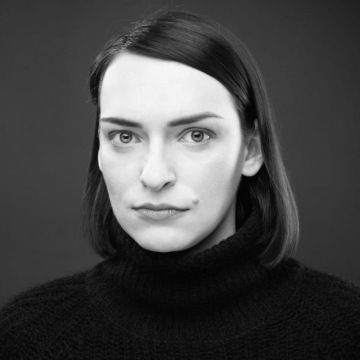Aliona Solomadina: Lightness
As part of its Facade Project series, Kunsthalle Praha presents a textual artwork by graphic designer Aliona Solomadina from Kyiv. Her large-format light installation Lehkost [Lightness] can be seen on the façade of what was formerly Prague's Zenger electrical substation. In the work, Solomadina alludes to both the brutalist architecture of Karel Prager and Milan Kundera's famous novel The Unbearable Lightness of Being.
Trained as a graphic designer, Aliona Solomadina works at the intersection between typography and conceptual art. One of her key sources of inspiration is architecture. In her native Kiev, she started developing the City of Forms project, which consists on investigating the city's architecture and urban life in a variety of ways: guided by Google Maps, taking notes, making photography. She examines every detail, every element carefully, and lets herself moved by her surroundings. This is how she captures shapes and then interprets and converts them into letterforms.
“I consider my graphic work for the façade of the Kunshalle Praha building as a city sign. It includes all the basic elements of one: light, colour and a message. As for light, it’s important for the city communications with its magic impact. I chose three basic colours (red, green and yellow) corresponding to the city transport – especially the metro lines. And the message appeared in my mind as a response to my productive search for letterforms during my exploration of the city. The word ‘Lehkost’ (Lightness) reflects my feelings and mood; it is a laconic intervention in the urban environment which encourages a search for personal routes (meanings), rhythms, tempos, and movement,”
explains Aliona Solomadina on the subject of her most recent work, created while she participated in an artist-in-residence programme organized by the Ukrainian Institute with the support of Kunsthalle Praha.
Although originally Solomadina had planned to study Prague's landmark buildings in the Gothic, Art Nouveau, and Neoclassicist styles, it was ultimately the Brutalist architecture that caught her attention – particularly the Federal Assembly Building by the communist-era architect Karel Prager, who also designed the National Theatre's New Stage. She was struck by the contrast between the solidity, the roughness of the materials and the apparent fragility of the structure. On this basis, Solomadina created an entire alphabet of her own in Prague.
The word Lehkost [Lightness] also refers to Milan Kundera's Unbearable Lightness of Being (1984), which is set in an occupied Czechoslovakia. It was when she read the novel, long before she actually visited the city herself, that Solomadina began forming her first impressions of Prague. She compares the title of the book to the kind of façade which inspired her own work:
“The idea for Lehkost came from two different types of ‘façades’: the architectural structure and the title of a novel, which can also be regarded as the façade of the text.”
The oxymoronic title The Unbearable Lightness of Being hides within it a profound meditation on the meaning of life. In the novel, Kundera analyzes the antagonism between heaviness and lightness from political, moral, and emotional points of view. Heaviness embodies the eternal return of things, a static vision of the world, while lightness is understood as a progressive, dynamic perspective. "What then shall we choose? Heaviness or lightness?" Such is the central question posed by the author.
In a world ruled by heaviness, Aliona Solomadina clearly draws us towards the lightness of being. Her light art will be viewable on the façade of the former Zenger electrical substation (Pod Bruskou 132/2, Prague 1) until June 2020.
Curator: Christelle Havranek
Project manager, accompanying programme: Kristýna Kottová
Photo © Filip Kopecký and © Lukáš Masner
ALIONA SOLOMADINA
Aliona Solomadina is an independent graphic designer and researcher who is currently based in Kyiv. She focuses on book design and the creation of visual identities, but also devotes herself to art direction and design curation. Over her professional career she has collaborated with a wide variety of cultural institutions, brands and companies, notably the PinchukArtCentre and Mystetskyi Arsenal. She became the chief designer of the national stand of Ukraine both at the Frankfurt Book Fair in 2015 and 2016 and at the Berlin Film Festival in 2017. In the past, she has pursued projects with the British Council in Ukraine, the Institute for Human Sciences in Vienna, the National Culture and Museum Complex and many others.
“A” stands for Aliona in the U,N,A collective design research trio.
FACADE PROJECT
Kunsthalle Praha presents a series of site-specific projects to be temporarily displayed on its facade, the only part of the building accessible to the public during the renovation.
Under the title Facade Project, this programme of commissioned outdoor artwork refers to the history of the building. The Zenger transformer substation’s facade was originally intended to exhibit a light-kinetic sculpture series by the avant-garde sculptor Zdeněk Pešánek. Sadly, this project, entitled One Hundred Years of Electricity, was never executed.
Paying tribute to Zdeněk Pešánek’s vision, Facade Project works as an experimental platform allowing artists to create installations using various media at the intersection of art and technology. Each step of the building’s transformation is accompanied by a specific artwork in dialogue with the architecture of the Zenger transformer substation and the surrounding neighbourhood. All the interventions are research-based, questioning the multi-layered context – geographical, political, social – of a place situated in the very heart of Prague.
Aside from stimulating the curiosity of the public, Facade Project functions as a laboratory that hints at Kunsthalle Praha’s indoor program to be presented from 2021.




